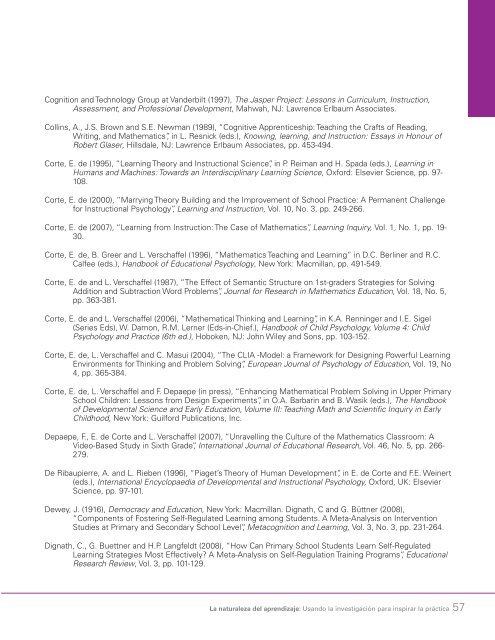del aprendizaje
s0eH3032Q2U
s0eH3032Q2U
Create successful ePaper yourself
Turn your PDF publications into a flip-book with our unique Google optimized e-Paper software.
Cognition and Technology Group at Vanderbilt (1997), The Jasper Project: Lessons in Curriculum, Instruction,<br />
Assessment, and Professional Development, Mahwah, NJ: Lawrence Erlbaum Associates.<br />
Collins, A., J.S. Brown and S.E. Newman (1989), “Cognitive Apprenticeship: Teaching the Crafts of Reading,<br />
Writing, and Mathematics”, in L. Resnick (eds.), Knowing, learning, and Instruction: Essays in Honour of<br />
Robert Glaser, Hillsdale, NJ: Lawrence Erlbaum Associates, pp. 453-494.<br />
Corte, E. de (1995), “Learning Theory and Instructional Science”, in P. Reiman and H. Spada (eds.), Learning in<br />
Humans and Machines: Towards an Interdisciplinary Learning Science, Oxford: Elsevier Science, pp. 97-<br />
108.<br />
Corte, E. de (2000), “Marrying Theory Building and the Improvement of School Practice: A Permanent Challenge<br />
for Instructional Psychology”, Learning and Instruction, Vol. 10, No. 3, pp. 249-266.<br />
Corte, E. de (2007), “Learning from Instruction: The Case of Mathematics”, Learning Inquiry, Vol. 1, No. 1, pp. 19-<br />
30.<br />
Corte, E. de, B. Greer and L. Verschaffel (1996), “Mathematics Teaching and Learning” in D.C. Berliner and R.C.<br />
Calfee (eds.), Handbook of Educational Psychology, New York: Macmillan, pp. 491-549.<br />
Corte, E. de and L. Verschaffel (1987), “The Effect of Semantic Structure on 1st-graders Strategies for Solving<br />
Addition and Subtraction Word Problems”, Journal for Research in Mathematics Education, Vol. 18, No. 5,<br />
pp. 363-381.<br />
Corte, E. de and L. Verschaffel (2006), “Mathematical Thinking and Learning”, in K.A. Renninger and I.E. Sigel<br />
(Series Eds), W. Damon, R.M. Lerner (Eds-in-Chief.), Handbook of Child Psychology, Volume 4: Child<br />
Psychology and Practice (6th ed.), Hoboken, NJ: John Wiley and Sons, pp. 103-152.<br />
Corte, E. de, L. Verschaffel and C. Masui (2004), “The CLIA -Mo<strong>del</strong>: a Framework for Designing Powerful Learning<br />
Environments for Thinking and Problem Solving”, European Journal of Psychology of Education, Vol. 19, No<br />
4, pp. 365-384.<br />
Corte, E. de, L. Verschaffel and F. Depaepe (in press), “Enhancing Mathematical Problem Solving in Upper Primary<br />
School Children: Lessons from Design Experiments”, in O.A. Barbarin and B. Wasik (eds.), The Handbook<br />
of Developmental Science and Early Education, Volume III: Teaching Math and Scientific Inquiry in Early<br />
Childhood, New York: Guilford Publications, Inc.<br />
Depaepe, F., E. de Corte and L. Verschaffel (2007), “Unravelling the Culture of the Mathematics Classroom: A<br />
Video-Based Study in Sixth Grade”, International Journal of Educational Research, Vol. 46, No. 5, pp. 266-<br />
279.<br />
De Ribaupierre, A. and L. Rieben (1996), “Piaget’s Theory of Human Development”, in E. de Corte and F.E. Weinert<br />
(eds.), International Encyclopaedia of Developmental and Instructional Psychology, Oxford, UK: Elsevier<br />
Science, pp. 97-101.<br />
Dewey, J. (1916), Democracy and Education, New York: Macmillan. Dignath, C and G. Büttner (2008),<br />
“Components of Fostering Self-Regulated Learning among Students. A Meta-Analysis on Intervention<br />
Studies at Primary and Secondary School Level”, Metacognition and Learning, Vol. 3, No. 3, pp. 231-264.<br />
Dignath, C., G. Buettner and H.P. Langfeldt (2008), “How Can Primary School Students Learn Self-Regulated<br />
Learning Strategies Most Effectively? A Meta-Analysis on Self-Regulation Training Programs”, Educational<br />
Research Review, Vol. 3, pp. 101-129.<br />
La naturaleza <strong>del</strong> <strong>aprendizaje</strong>: Usando la investigación para inspirar la práctica 57


